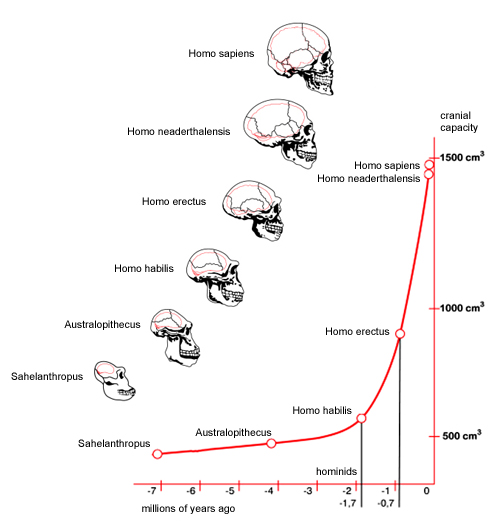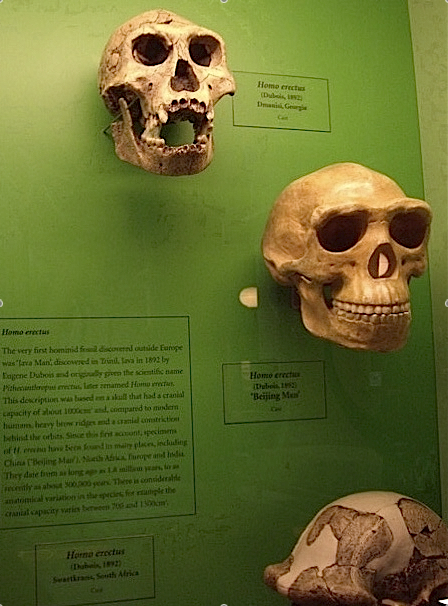Big Brain, The Origins and Future of Human Intelligence.
.
|
 |
Gary Lynch & Richard Granger.
"Each of us balances the world that is actually out there against our mind's own internally constructed version of it. Maintaining this balance is one of life's daily challenges."
"we occasionally act on our imagined view of the world...."
"...to match their internal representations with real external events." |
| Homo erectus |
p. 175 |
"For one thing, big brains acquire a truly immense capacity for storing arbitrary information....The capacity of memory seems mind-numbingly, almost impractically huge, beyond anything we can imagine using it for....In our brains, the extra capacity is so excessive that the pictures run together to be nearly continuous. The resulting 'episodic' memory is prevalent in us....This ability may be at the heart of human intelligence: the capacity to take a series of past experiences, and manipulate them to produce different outcomes."
questions | graphics | photographs of crania | argument | hypothesis | conclusion
"Who were our bigger-brained ancestors of the recent past?
Why did they die out?"
"Who are our ancestors, and what was their evolutionary path to us?"
"...connectivity between brain areas determines the processing paths or 'assembly lines' in the brain, and how subtle differences in the "
p. 14
"The Boskops coexisted with our Homo Sapiens fore bearers."
"We shared the earth with the Boskops and their bigger brains for tens of thousands of years....the specter of the even larger brains that came before us."
p. 15.

"Figure 4. Change in brain cavity size among hominids, showing a general trend towards larger brains in human evolution."
Source is:
http://readingevolution.com/hominid_evolution.html
"Human brains are qualitatively the same as those of other primates; the primary difference is that they are enormous.... relative parts did not change; just grew."
Something caused great brain increases twice: two million years ago, and half a million years ago."
p. 154.
questions | graphics | photographs of crania | argument | hypothesis | conclusion
From prosimians (Lemurs) to monkeys, to apes (chimpanzees) to primates:

Cranial capacity enlarged three times over in a relatively short span of geological time.
[Siry,2008: Oxford Museum]
"In both cases there were big increases in the size of the newborn baby."
Australopithecus to Homo, and then from Homo habilis to Homo sapiens.
p.154.
"The first brain size jump occurred when homo habilis and erectus split from Australopithecus. They began to walk upright, erasing a constraint that had kept the size of the fetus small."
"As a side effect (of a lower trunk than apes), our lengthened lower trunk makes an extended space into which the uterus can expand during pregnancy."
"The apes" had "a particular way of walking, which had the side-effect of restricting newborn size, and this closed off the possibility of their brains expanding "
Ibid. p.156.
start | reality | source | questions | graphics | photographs of crania | argument | hypothesis | conclusion

The second shift is hypothesized to have been a response to a change in the female pelvis that had no known cause but "the pelvic girdle of female humans is noticeably different from that of males, perhaps in response to difficulties of being pregnant while walking upright."
allowed larger babies --"And as we have seen larger babies grow larger brains."
"Tool use didn't prompt brain expansion. Rather, walking expanded brain size, and the bigger brain was able to conceive of tool construction and use."
bipedalism, baby size, tool use, and sexual dimorphism, now fits cogently together."
pp.156.
start | reality | source | questions | graphics | photographs of crania | argument | hypothesis | conclusion
Boskop is a town in South Africa inland from Port Elizabeth here in a field two Afrikaans farmers found in 1913 and unusual human fossil cranial bone.
"calculation by the method of Broca gives a minimum figure of 1825 cc (cubic centimeters)."
"possessed a brain perhaps 25 percent or more greater than our own."
pp. 161-162.

"He lived in Africa. His brain was bigger than your brain"
Loren Eisely, The Immense Journey.
QUOTED IN Lynch and Granger, pp. 161-163.
Big Brain, The Origins and Future of Human Intelligence. Gary Lynch & Richard Granger. Palgrave, 2008 [New York: St. Martins Press, 2008]. 215 pages and notes.
Science is a story






